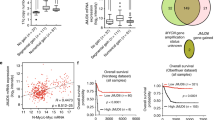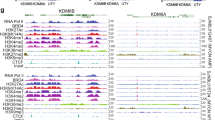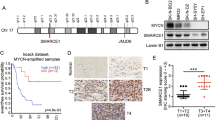Abstract
The Polycomb transcription repressor BMI1 is highly expressed in human neuroblastomas and is required for the clonogenic self-renewal and tumorigenicity of human neuroblastoma cell lines. The molecular basis of BMI1 action in neuroblastoma cells is not well understood. Here we report that BMI1 has a critical role in stabilizing cyclin E1 by repressing the expression of FBXW7, a substrate-recognition subunit of the SCF E3 ubiquitin ligase that targets cyclin E1 for degradation. BMI1 binds to the FBXW7 locus in vivo and represses its mRNA expression. Overexpression of cyclin E1 or abrogation of FBXW7 induction rescues the cell-death phenotype of BMI1 knockdown. Moreover, MYCN, an oncoprotein in the pathogenesis of high-risk neuroblastomas, is able to counteract the death-inducing effect of BMI1 knockdown by activating CCNE1 transcription. We further show that high cyclin E1 expression is associated with Stage 4 neuroblastomas and poor prognosis in patients. These findings suggest a molecular mechanism for the oncogenic activity of BMI1 and MYCN in neuroblastoma pathogenesis and progression by maintaining cyclin E1 levels.
This is a preview of subscription content, access via your institution
Access options
Subscribe to this journal
Receive 50 print issues and online access
$259.00 per year
only $5.18 per issue
Buy this article
- Purchase on Springer Link
- Instant access to full article PDF
Prices may be subject to local taxes which are calculated during checkout







Similar content being viewed by others
References
Asgharzadeh S, Pique-Regi R, Sposto R, Wang H, Yang Y, Shimada H et al. (2006). Prognostic significance of gene expression profiles of metastatic neuroblastomas lacking MYCN gene amplification. J Natl Cancer Inst 98: 1193–1203.
Brodeur GM . (2003). Neuroblastoma: biological insights into a clinical enigma. Nat Rev Cancer 3: 203–216.
Bruggeman SW, Valk-Lingbeek ME, van der Stoop PP, Jacobs JJ, Kieboom K, Tanger E et al. (2005). Ink4a and Arf differentially affect cell proliferation and neural stem cell self-renewal in Bmi1-deficient mice. Genes Dev 19: 1438–1443.
Chang H-H, Lee H, Hu M-K, Tsao P-N, Juan H-F, Huang M-C et al. (2010). Notch1 expression predicts an unfavorable prognosis and serves as a therapeutic target of patients with neuroblastoma. Clin Cancer Res 16: 4411–4420.
Chen QR, Song YK, Wei JS, Bilke S, Asgharzadeh S, Seeger RC et al. (2008). An integrated cross-platform prognosis study on neuroblastoma patients. Genomics 92: 195–203.
Crusio KM, King B, Reavie LB, Aifantis I . (2010). The ubiquitous nature of cancer: the role of the SCF(Fbw7) complex in development and transformation. Oncogene 29: 4865–4873.
Cui H, Li T, Ding HF . (2005). Linking of N-Myc to death receptor machinery in neuroblastoma cells. J Biol Chem 280: 9474–9481.
Cui H, Hu B, Li T, Ma J, Alam G, Gunning WT et al. (2007). Bmi-1 is essential for the tumorigenicity of neuroblastoma cells. Am J Pathol 170: 1370–1378.
Cui H, Ma J, Ding J, Li T, Alam G, Ding HF . (2006). Bmi-1 regulates the differentiation and clonogenic self-renewal of I-type neuroblastoma cells in a concentration-dependent manner. J Biol Chem 281: 34696–34704.
Ferrari-Toninelli G, Bonini SA, Uberti D, Buizza L, Bettinsoli P, Poliani PL et al. (2010). Targeting Notch pathway induces growth inhibition and differentiation of neuroblastoma cells. Neuro-Oncol 12: 1231–1243.
Haupt Y, Alexander WS, Barri G, Klinken SP, Adams JM . (1991). Novel zinc finger gene implicated as myc collaborator by retrovirally accelerated lymphomagenesis in E mu-myc transgenic mice. Cell 65: 753–763.
Hwang HC, Clurman BE . (2005). Cyclin E in normal and neoplastic cell cycles. Oncogene 24: 2776–2786.
Iwama A, Oguro H, Negishi M, Kato Y, Morita Y, Tsukui H et al. (2004). Enhanced self-renewal of hematopoietic stem cells mediated by the polycomb gene product Bmi-1. Immunity 21: 843–851.
Jacobs JJ, Kieboom K, Marino S, DePinho RA, van Lohuizen M . (1999a). The oncogene and Polycomb-group gene bmi-1 regulates cell proliferation and senescence through the ink4a locus. Nature 397: 164–168.
Jacobs JJ, Scheijen B, Voncken JW, Kieboom K, Berns A, van Lohuizen M . (1999b). Bmi-1 collaborates with c-Myc in tumorigenesis by inhibiting c-Myc-induced apoptosis via INK4a/ARF. Genes Dev 13: 2678–2690.
Jansen-Durr P, Meichle A, Steiner P, Pagano M, Finke K, Botz J et al. (1993). Differential modulation of cyclin gene expression by MYC. Proc Natl Acad Sci USA 90: 3685–3689.
Kaghad M, Bonnet H, Yang A, Creancier L, Biscan JC, Valent A et al. (1997). Monoallelically expressed gene related to p53 at 1p36, a region frequently deleted in neuroblastoma and other human cancers. Cell 90: 809–819.
Lessard J, Sauvageau G . (2003). Bmi-1 determines the proliferative capacity of normal and leukaemic stem cells. Nature 423: 255–260.
Lowe SW, Sherr CJ . (2003). Tumor suppression by Ink4a-Arf: progress and puzzles. Curr Opin Genet Dev 13: 77–83.
Ma CX, Janetka JW, Piwnica-Worms H . (2011). Death by releasing the breaks: CHK1 inhibitors as cancer therapeutics. Trends Mol Med 17: 88–96.
Mao L, Ding J, Zha Y, Yang L, McCarthy BA, King W et al. (2011). HOXC9 links cell-cycle exit and neuronal differentiation and is a prognostic marker in neuroblastoma. Cancer Res 71: 4314–4324.
Maris JM, Matthay KK . (1999). Molecular biology of neuroblastoma. J Clin Oncol 17: 2264–2279.
Martin SJ, Reutelingsperger CP, McGahon AJ, Rader JA, van Schie RC, LaFace DM et al. (1995). Early redistribution of plasma membrane phosphatidylserine is a general feature of apoptosis regardless of the initiating stimulus: inhibition by overexpression of Bcl-2 and Abl. J Exp Med 182: 1545–1556.
Minella AC, Swanger J, Bryant E, Welcker M, Hwang H, Clurman BE . (2002). p53 and p21 form an inducible barrier that protects cells against cyclin E-cdk2 deregulation. Curr Biol 12: 1817–1827.
Molofsky AV, He S, Bydon M, Morrison SJ, Pardal R . (2005). Bmi-1 promotes neural stem cell self-renewal and neural development but not mouse growth and survival by repressing the p16Ink4a and p19Arf senescence pathways. Genes Dev 19: 1432–1437.
Molofsky AV, Pardal R, Iwashita T, Park IK, Clarke MF, Morrison SJ . (2003). Bmi-1 dependence distinguishes neural stem cell self-renewal from progenitor proliferation. Nature 425: 962–967.
Nakayama KI, Nakayama K . (2006). Ubiquitin ligases: cell-cycle control and cancer. Nat Rev Cancer 6: 369–381.
Nowak K, Kerl K, Fehr D, Kramps C, Gessner C, Killmer K et al. (2006). BMI1 is a target gene of E2F-1 and is strongly expressed in primary neuroblastomas. Nucleic Acids Res 34: 1745–1754.
Oberthuer A, Berthold F, Warnat P, Hero B, Kahlert Y, Spitz R et al. (2006). Customized oligonucleotide microarray gene expression-based classification of neuroblastoma patients outperforms current clinical risk stratification. J Clin Oncol 24: 5070–5078.
Ochiai H, Takenobu H, Nakagawa A, Yamaguchi Y, Kimura M, Ohira M et al. (2010). Bmi1 is a MYCN target gene that regulates tumorigenesis through repression of KIF1Bbeta and TSLC1 in neuroblastoma. Oncogene 29: 2681–2690.
Onoyama I, Nakayama KI . (2008). Fbxw7 in cell cycle exit and stem cell maintenance: insight from gene-targeted mice. Cell Cycle (Georgetown, Tex) 7: 3307–3313.
Otto T, Horn S, Brockmann M, Eilers U, Schuttrumpf L, Popov N et al. (2009). Stabilization of N-Myc is a critical function of Aurora A in human neuroblastoma. Cancer Cell 15: 67–78.
Park IK, Morrison SJ, Clarke MF . (2004). Bmi1, stem cells, and senescence regulation. J Clin Invest 113: 175–179.
Park IK, Qian D, Kiel M, Becker MW, Pihalja M, Weissman IL et al. (2003). Bmi-1 is required for maintenance of adult self-renewing haematopoietic stem cells. Nature 423: 302–305.
Perez-Roger I, Solomon DL, Sewing A, Land H . (1997). Myc activation of cyclin E/Cdk2 kinase involves induction of cyclin E gene transcription and inhibition of p27(Kip1) binding to newly formed complexes. Oncogene 14: 2373–2381.
Riccardi C, Nicoletti I . (2006). Analysis of apoptosis by propidium iodide staining and flow cytometry. Nat Protoc 1: 1458–1461.
Satyanarayana A, Kaldis P . (2009). Mammalian cell-cycle regulation: several Cdks, numerous cyclins and diverse compensatory mechanisms. Oncogene 28: 2925–2939.
Sauvageau M, Sauvageau G . (2010). Polycomb group proteins: multi-faceted regulators of somatic stem cells and cancer. Cell Stem Cell 7: 299–313.
Schwab M . (2004). MYCN in neuronal tumours. Cancer Lett 204: 179–187.
Schwartz YB, Pirrotta V . (2007). Polycomb silencing mechanisms and the management of genomic programmes. Nat Rev Genet 8: 9–22.
Silva JM, Marran K, Parker JS, Silva J, Golding M, Schlabach MR et al. (2008). Profiling essential genes in human mammary cells by multiplex RNAi screening. Science 319: 617–620.
Spruck CH, Won K-A, Reed SI . (1999). Deregulated cyclin E induces chromosome instability. Nature 401: 297–300.
Steiner P, Philipp A, Lukas J, Godden-Kent D, Pagano M, Mittnacht S et al. (1995). Identification of a Myc-dependent step during the formation of active G1 cyclin-cdk complexes. EMBO J 14: 4814–4826.
Thompson SL, Bakhoum SF, Compton DA . (2010). Mechanisms of chromosomal instability. Curr Biol 20: R285–R295.
Valk-Lingbeek ME, Bruggeman SW, van Lohuizen M . (2004). Stem cells and cancer; the polycomb connection. Cell 118: 409–418.
van der Lugt NM, Domen J, Linders K, van Roon M, Robanus-Maandag E, te Riele H et al. (1994). Posterior transformation, neurological abnormalities, and severe hematopoietic defects in mice with a targeted deletion of the bmi-1 proto-oncogene. Genes Dev 8: 757–769.
van Lohuizen M, Verbeek S, Scheijen B, Wientjens E, van der Gulden H, Berns A . (1991). Identification of cooperating oncogenes in E mu-myc transgenic mice by provirus tagging. Cell 65: 737–752.
Wei JS, Greer BT, Westermann F, Steinberg SM, Son CG, Chen QR et al. (2004). Prediction of clinical outcome using gene expression profiling and artificial neural networks for patients with neuroblastoma. Cancer Res 64: 6883–6891.
Wei W, Hemmer RM, Sedivy JM . (2001). Role of p14(ARF) in replicative and induced senescence of human fibroblasts. Mol Cell Biol 21: 6748–6757.
Welcker M, Clurman BE . (2008). FBW7 ubiquitin ligase: a tumour suppressor at the crossroads of cell division, growth and differentiation. Nat Rev Cancer 8: 83–93.
Yamashita M, Kuwahara M, Suzuki A, Hirahara K, Shinnaksu R, Hosokawa H et al. (2008). Bmi1 regulates memory CD4T cell survival via repression of the Noxa gene. J Exp Med 205: 1109–1120.
Acknowledgements
We thank Q Du for pKMyc-cyclinE1, G Hannon and J Silva for shRNAmir Tet-Off, R Mulligan for pHDM-G and pMD.MLVogp, W Wei for pBabe-puro-p14ARF and J Khan for gene expression data sets from the Oncogenomics Database. This work was supported by the NIH grant CA124982 and a Georgia Cancer Coalition Distinguished Scholar Award (H-FD), and a grant from the National Basic Research Program of China (No. 2012cb114603) to HC. LM was supported in part by a grant from the National Science Foundation of China (NSFC 81101905).
Author information
Authors and Affiliations
Corresponding authors
Ethics declarations
Competing interests
The authors declare no conflict of interest.
Additional information
Supplementary Information accompanies the paper on the Oncogene website
Supplementary information
Rights and permissions
About this article
Cite this article
Mao, L., Ding, J., Perdue, A. et al. Cyclin E1 is a common target of BMI1 and MYCN and a prognostic marker for neuroblastoma progression. Oncogene 31, 3785–3795 (2012). https://doi.org/10.1038/onc.2011.536
Received:
Revised:
Accepted:
Published:
Issue Date:
DOI: https://doi.org/10.1038/onc.2011.536
Keywords
This article is cited by
-
TP53 and TP53-associated genes are correlated with the prognosis of paediatric neuroblastoma
BMC Genomic Data (2022)
-
Bioinformatic screening for candidate biomarkers and their prognostic values in endometrial cancer
BMC Genetics (2020)
-
MYCN and PRC1 cooperatively repress docosahexaenoic acid synthesis in neuroblastoma via ELOVL2
Journal of Experimental & Clinical Cancer Research (2019)
-
Glycine decarboxylase is a transcriptional target of MYCN required for neuroblastoma cell proliferation and tumorigenicity
Oncogene (2019)
-
Neuroblastoma cells depend on HDAC11 for mitotic cell cycle progression and survival
Cell Death & Disease (2017)



